Set out on a cultural journey through Tokyo’s traditional Sumo Wrestling Tournament Experience. Witness the colossal wrestlers engage in fierce competition at the historic Ryogoku Kokugikan stadium.
This professional guide provides insights into the blend of athleticism, tradition, and spirituality that defines sumo. Learn about the ranking system, techniques, and religious significance of this revered sport.
Discover practical details on ticket booking and tour inclusions, and learn about the heart of Japan’s sumo wrestling scene.
Just The Basics
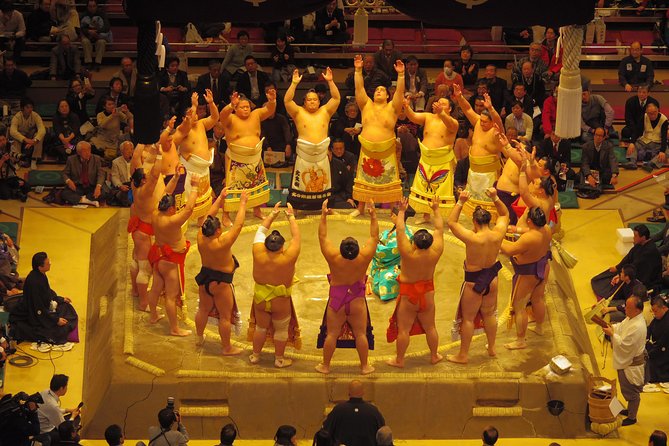
- Experience the thrill of Japanese sumo wrestling in Tokyo
- Gain insights into sumo culture and traditions from professional guides
- Enjoy the exciting atmosphere of a traditional sporting event
- Immerse in the history and techniques of sumo wrestling
Here's some other great tours and experiences nearby we think you'll like.
Tournament Overview
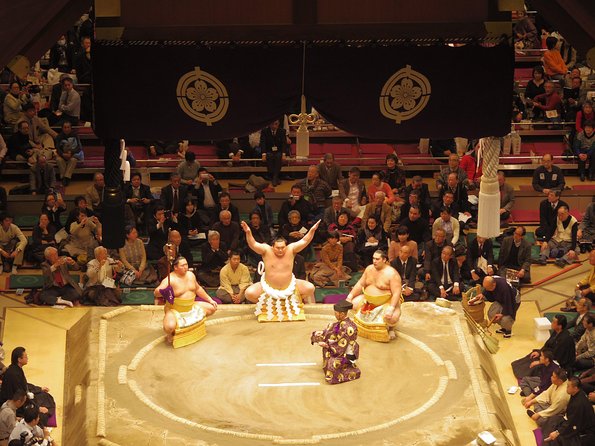
Experience the thrill of Japanese sumo wrestling firsthand by attending one of the three annual tournaments held in Tokyo. Enjoy traditional rituals and culture as you watch massive sumo wrestlers compete at Ryogoku Kokugikan stadium.
Witness the excitement of this traditional sporting event while learning about sumo culture and traditions. These tournaments offer a unique opportunity to explore the world of sumo, where Shinto rituals before matches and the sacredness of the ring showcase the deep ties to Japanese culture and history.
Inclusions and Logistics

For a seamless and hassle-free experience at the Sumo Wrestling Tournament in Tokyo, the tour package includes a Sumo tournament chair C ticket, a local and professional speaking guide, hotel pickup and drop-off, food and drinks, and transportation fee to the meeting point at Ryogoku Station. This package ensures guests have everything they need for a day filled with culture and excitement. Hotel accommodations are not included in the package, but the convenience of being picked up and dropped off at the hotel adds to the overall experience. The knowledgeable guide will provide insights into the world of sumo wrestling, making this tour a perfect choice for those seeking an insider’s perspective.
| Inclusions | Details |
|---|---|
| Sumo tournament ticket | Chair C ticket for the tournament |
| Professional guide | Local expert guide for insights |
| Transportation | Pickup, drop-off, and transport to the venue |
Expectations at the Tournament
Enjoy the rich history and traditions of sumo wrestling as you visit the Ryogoku Kokugikan for the tournament. Here’s what to expect at the event:
-
Fan Interactions and Cultural Immersion: Engage with passionate sumo fans and experience the deep-rooted traditions of this ancient sport.
-
Food Options: Enjoy a variety of sumo-themed snacks and traditional Japanese cuisine available at the venue to enhance your overall experience.
-
Surrounding Area: Explore the vibrant Ryogoku neighborhood, known for its sumo stables, sumo-themed restaurants, and the informative Sumo Museum, adding depth to your understanding of this unique cultural phenomenon.
Reviews and Feedback

Visitors consistently praise the knowledgeable guides and immersive sumo experience on this Tokyo tournament tour. With a 5.0 overall rating based on 168 reviews, customer satisfaction is evident. Travelers commend the guides for providing valuable insights into the culture of sumo wrestling.
Recommendations for the tour highlight its ability to showcase the cultural significance of this traditional sport. The tour not only offers a unique experience but also allows attendees to witness the matches live, adding to the thrill. Comments on the cultural significance of sumo reveal the deep connection it has to Japanese history.
Wrestlers Ranking System
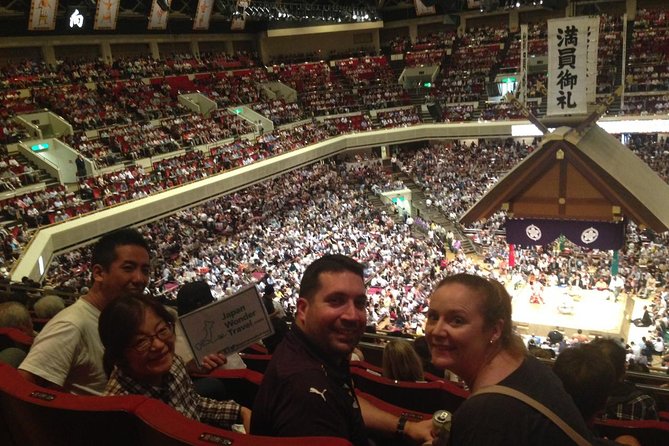
The wrestlers ranking system in sumo is based on performance and features criteria for promotion and demotion, with Yokozuna being the highest rank achievable through winning matches and climbing ranks. When considering a wrestler’s position within the ranking system, the following aspects are crucial:
-
Promotion Criteria:
- Wrestlers must achieve a winning record against opponents in higher ranks.
- Consistent performance and victories in tournaments are essential.
- Exceptional skill and demonstration of traditional sumo techniques can contribute to promotion.
-
Demotion Rules:
- A series of consecutive losses may lead to demotion.
- Failure to maintain a competitive edge can result in moving down the ranks.
- Injuries impacting performance may also influence demotion decisions.
Sumo Techniques
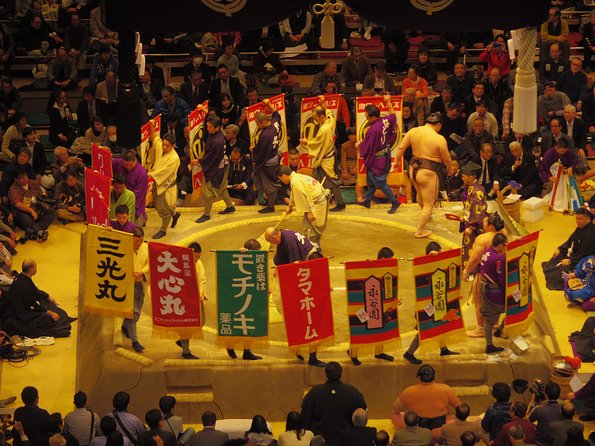
For those interested in delving into the world of sumo wrestling, understanding the intricate techniques utilized by wrestlers is essential for appreciating the sport’s complexity and skill. Sumo wrestlers employ a combination of pushing and thrusting moves, along with belt techniques for throws, to outmaneuver their opponents.
Defensive strategies are crucial in the ring, where wrestlers leverage their weight advantage to gain the upper hand. These techniques are honed through rigorous strength training and agility drills, emphasizing the physical demands of the sport.
Religious Significance of Sumo
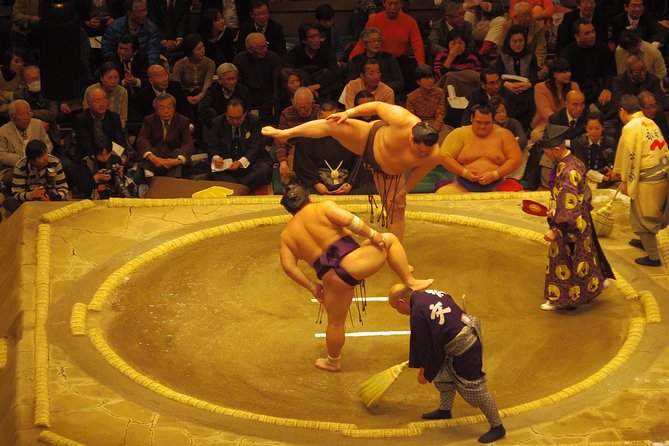
Mastering the intricate techniques of sumo wrestling not only showcases the physical prowess of the wrestlers but also unveils the deep-rooted religious significance embedded in the sport. Sumo holds immense importance in Japanese culture, with several rituals and ceremonies adding to its sacred nature.
Here are some aspects highlighting the religious significance of sumo:
-
Shinto Rituals: Before matches, wrestlers partake in Shinto rituals to purify themselves and the ring, honoring tradition and spirituality.
-
Sacred Sport: Sumo is considered a sacred sport in Japan, with the sumo ring being viewed as a consecrated space where tradition, respect, and history converge.
-
Purification Ceremonies: These ceremonies play a crucial role in maintaining the sanctity and reverence associated with sumo.
Frequently Asked Questions
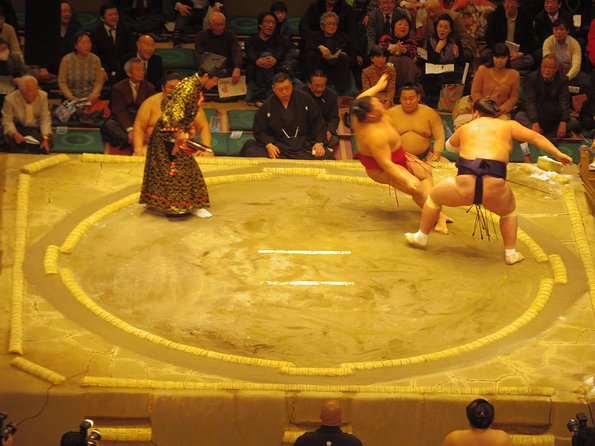
How Long Does a Typical Sumo Wrestling Tournament Last in Tokyo?
A typical sumo wrestling tournament in Tokyo lasts about 15 days, following a set schedule. The length allows for various matches and rankings to unfold. It’s an exciting event that showcases the tradition and skill of sumo wrestlers.
Are There Any Specific Rules or Etiquette That Spectators Should Follow While Attending a Sumo Tournament?
When attending a sumo tournament, spectators should abide by specific rules and etiquette. Respectful behavior, such as refraining from loud cheering during bouts and not throwing cushions into the ring, is crucial to uphold cultural norms and enhance the tournament atmosphere.
Can Spectators Interact With the Sumo Wrestlers or Get Autographs During the Tournament?
Spectators at sumo tournaments typically cannot interact with wrestlers or get autographs during the event. Wrestler interactions, autograph sessions, fan engagement, and meet and greet opportunities are limited due to the wrestlers’ focus and the structured nature of the tournament.
Are There Any Traditional Foods or Snacks That Are Commonly Enjoyed During Sumo Tournaments in Tokyo?
Traditional snacks like chankonabe stew and rice balls are popular at sumo tournaments in Tokyo. Visitors can also find sumo merchandise, cultural souvenirs, and various food stalls offering a taste of authentic Japanese cuisine.
Are There Any Opportunities for Visitors to Participate in Sumo-Related Activities or Experiences During the Tournament?
Visitors can engage in interactive workshops and cultural experiences during the tournament. These activities offer a hands-on approach to understanding sumo traditions. It’s a budget-friendly way to take in the world of sumo wrestling.
Final Words
Experience the thrill and tradition of sumo wrestling in Tokyo with a Sumo Wrestling Tournament Experience. Enjoy the world of sumo culture, witness fierce competition, and explore the historic Ryogoku Kokugikan stadium with a professional guide.
Gain insights into the ranking system, techniques, and religious significance of sumo. Book your tickets and join the excitement of this unique sporting event for an unforgettable cultural experience in Japan.
